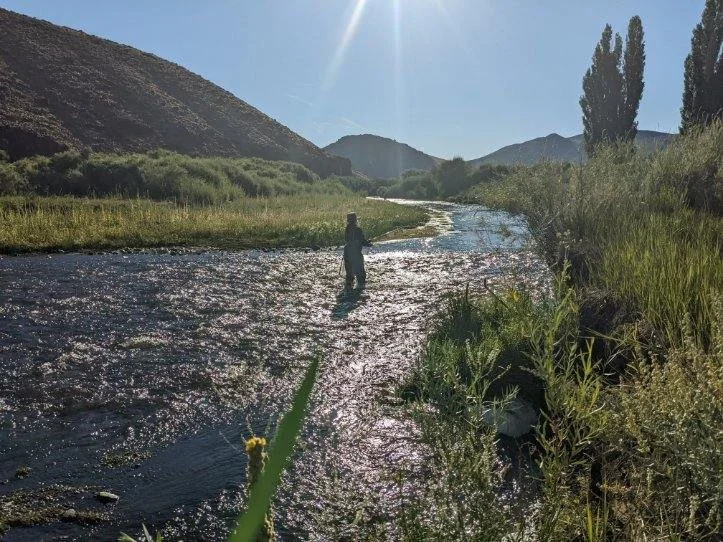History
Walker Basin Conservancy’s restoration goal is to increase natural flows in the Walker River to restore and maintain Walker Lake as a vibrant Ecosystem. 50,000 Acre Feet (AF) of reliable water to the lake will reduce long-term Total Dissolved Solids (TDS) averages to between 10,000 mg/L and 12,000 mg/L, supporting key species including Lahontan Cutthroat Trout.
This is the range where indicator species will once again be abundant in Walker Lake. As part of understanding the overall condition of Walker Lake, it is important to identify key categories of “indicator species.” As salinity levels of the lake fluctuate with rising or falling lake elevation, the health of indicator species can be used to determine the overall condition of the lake ecosystem.
CONFIRM DELETE/LINKS LOSS BELOW?
For decades, diversions from the Walker River have sustained a strong agricultural economy and community but produced an unintended consequence: dramatically reduced freshwater inflows to Walker Lake, a natural desert terminal lake at the terminus of the Walker River in Nevada.
During the last quarter of the 19th century, farmers and ranchers established communities in the Walker Basin, part of the ancestral home of the Northern Paiute people. Natural flows from the Walker River were diverted to support hay, pasture and other irrigated crops.
In the 1920s, the newly formed Walker River Irrigation District built a pair of dams on the east and west forks of the Walker River to store winter and early spring runoff for use later in the season when natural flows could not sustain the need of irrigated agriculture. Additionally, in 1935 the Bureau of Indian Affairs (BIA) built Weber Dam on the lower Walker River to capture surplus flows for irrigation on the Walker River Paiute Tribe’s Reservation.
As a result of declining water levels, Total Dissolved Solids (TDS) in Walker Lake has increased dramatically to the point that the lake can no longer support its native fish and wildlife populations. The Walker Basin Conservancy acquires water from willing sellers to restore and maintain Walker Lake.
plant faqs
Why choose locally grown native plants? Many reasons!
Locally adapted native plants are self-sustaining. As much as possible in our projects, we try to use seed collected from plants grown within the Walker Basin, because these plants are adapted to our local environment. They are more likely to survive our freezing winters and hot, dry summers. Most importantly, locally grown native plants often do not require supplemental irrigation after they have become established in the landscape. By considering elevation, precipitation, and soil type, you can carefully choose native plants that will sustain themselves in a particular area.
Native plants benefit wildlife. Native plants, pollinators, and other wildlife have coevolved (where multiple species reciprocally influence each other’s evolution) for thousands of years, creating intricate relationships between plants and animals. Non-native plants that evolved in other regions often provide lower quality habitat and do not support native wildlife as well. Some non-native plant species also become invasive and dominate the landscape, reducing habitat diversity, which in turn reduces wildlife diversity.
Many native plants in the Walker Basin have cultural value and provide medicinal and culinary benefits.
Why use transplants in restoration projects instead of direct sowing seed into the ground?
We are able to jumpstart plant communities at our restoration sites if we plant transplants when they are about 6 months old. We see more plant survival and restoration success with this method over direct sowing. Many of our native plant communities depend on a variety of shrubs which help get our affected lands on the right trajectory to support wildlife and greater plant diversity. Many native shrubs in the Walker Basin, however, have strong seed dormancy. Since most native shrubs produce seed towards the end of the growing season in the fall, any young seedlings would be vulnerable to frost if they sprouted right away. Instead, these seeds have adapted to remain dormant through the winter, until the next growing season begins in the spring. Often, they’ll stay dormant through multiple winters! To germinate these seeds year-round in our nursery, we have to break dormancy in the seeds by keeping them in damp soil in the fridge. This simulates mild, wet winter conditions – ideal for the seeds. Growing plants this way allows us to boost germination rates and get more plants from less seed. By transplanting older plants, we are also shortening the time until they will reproduce and create more plants in an area.
What plants are growing in the nursery and in our fields?
Grasses:
Bluebunch wheatgrass (Pseudoroegneria spicata)
Bottlebrush squirreltail (Elymus elymoides)
Creeping wildrye, aka Beardless wildrye (Leymus triticoides)
Sandberg bluegrass (Poa secunda)
Sand dropseed (Sporobolus cryptandrus)
Indian ricegrass (Achnatherum hymenoides)
Forbs (Herbaceous Wildflowers):
Yarrow (Achillea millefolium)
Nettleleaf giant hyssop (Agastache urticifolia)
Flatbud prickly poppy (Argemone munita)
Narrow-leaved milkweed (Asclepias fascicularis)
Showy milkweed (Asclepias speciosa)
Arrowleaf balsamroot (Balsamorhiza sagittata)
Douglas’ dusty maiden (Chaenactis douglasii)
Tapertip hawksbeard (Crepis acuminata)
Desert trumpet (Eriogonum inflatum)
Sulphur-flower buckwheat (Eriogonum umbellatum)
Hoary tansyaster (Machaeranthera canescens)
Nevada goldenrod (Solidago spectabilis)
Desert globemallow (Sphaeralcea ambigua)
Prince’s plume (Stanleya pinnata)
Panamint prince’s plume (Stanleya elata)
Shrubs:
Basin big sagebrush (Artemisia tridentata ssp. tridentata)
Wyoming big sagebrush (Artemisia tridentata ssp. wyomingensis)
Fourwing saltbush (Atriplex canescens)
Torrey’s quailbush (Atriplex torreyi)
Red-osier dogwood (Cornus sericea)
Rubber rabbitbrush (Ericameria nauseosa)
Spiny hopsage (Grayia spinosa)
Winterfat (Krascheninnikovia lanata)
Black greasewood (Sarcobatus vermiculatus)
Bailey’s greasewood (Sarcobatus baileyi)
Desert snowberry (Symphoricarpos longiflorus)
Antelope bitterbrush (Purshia tridentata)
Woods’ rose (Rosa woodsii)
Coyote willow (Salix exigua)
Trees:
Fremont cottonwood (Populus fremontii)
Peachleaf willow (Salix amygdaloides)
Red willow (Salix laevigata)
Shining willow (Salix lucida)
Yellow willow (Salix lutea)
Joshua tree (Yucca brevifolia)

